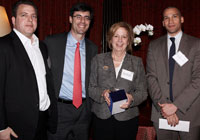
The value of nonprofit board members – beyond money and name-recognition – was given much deserved recognition last week when the first Brooke W. Mahoney Award was presented to Harlem RBI by the Volunteer Consulting Group.
Photo: Courtesy VCG, Theodore Samuels Photography
Happily, many nonprofit boards do all these things, although their efforts are too seldom recognized. For those who are foundering, confused or seeking to better themselves, resources abound. Governance Matters and BoardSource are just two of many.
How has your board risen to the challenges of 2009? How is it planning to deal with the trials of 2010? What have you learned about your board during the economic crisis?
The winning board had, indeed, done much to raise and maintain funding during the 2009 downturn, including upping their own donations, so programs could be maintained.
The other contenders were worth applauding as well: The Fortune Society, Cultivating Our Sisterhood International Association, Inc., The Brotherhood/Sister SOL, and Community Voices Heard. They pulled their organizations through the crunch by:
- foresight and proactive planning;
- creatively revamping but not diminishing employee benefits;
- developing new community-based fundraising events;
- adding board members who could provide needed expertise to keep projects going.
These boards, like those of thousands of nonprofits are the lynchpins of successful, sustained nonprofit service. The mix of board members, their understanding and enthusiastic acceptance of their roles, and continued support and training for board members are essential to the success of the nonprofit sector
There, I’ve done my soapbox bit! Now to the essence of board leadership and good nonprofit management as exemplified by these five boards:
- Careful assessment of skills needed by the organization, then focused recruitment of new board members who have those skills;
- Clear understanding between board member and the organization about what board members are expected to contribute financially, in time (attending meetings, etc.) and through in-kind work;
- On-going evaluation of all board members by the Governance Committee;
- Committee structure on the board that requires involvement of all board members;
- A plan – whether a strategic plan, a contingency plan or an economic plan – that has board buy-in and that clearly maps out the mission and the means of achieving it over a given period of years;
- A problem-solving, involved board that asks questions rather than just listening to staff reports and nodding its collective head;
- Staff involvement and bottom-up input to crisis management;
- Deep emotional involvement of the board with the organization such that board members are eager to help during crises;
- Client representation on the board so the culture and real needs of clients is part of board discussions and decisions.
Happily, many nonprofit boards govern well, although their efforts are too seldom recognized. For those who are foundering, confused or seeking to better themselves, resources abound. Governance Matters and BoardSource are just two of many.
How has your board risen to the challenges of 2009? How is it planning to deal with the trials of 2010? What have you learned about your board during the economic crisis?
